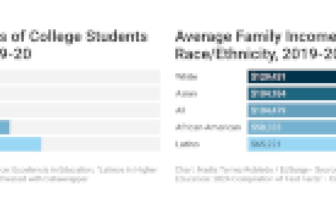What Brings Gen Z to the Library?

[ad_1]
Gen Zers, born between 1997 and 2012, spend a lot of time online, consuming and creating digital content. Ninety-two percent check social media daily. But they still like print, and they still like to go to the library, according to a survey of Gen Z and Millennial public library use and media consumption released by the American Library Association last fall. With Gen Z now making up a substantial portion of today’s college students, their attitudes toward libraries have implications for higher education.
“The report is quite interesting from an academic library perspective,” said Beth McNeil, 2023-2024 president of the Association of College and Research Libraries and dean of libraries at Purdue University. “A number of ACRL members would say ‘Wow, we see a lot of similarities in terms of usage and media consumption.’”
The study’s authors, Kathi Inman Berens and Rachel Noorda of Portland State University, analyzed quantitative data from about 2,000 respondents, roughly divided between Gen Zers and Millennials. They also did ethnographic research at two Ohio public library branches. They found that young people look to libraries to provide safe places to hang out and to access resources like free Wi-Fi, makerspaces, and tech equipment — expectations they carry with them to college, according to people who work in and with academic libraries.
At Purdue, a staggering 98 percent of undergraduates actually spend time in the libraries, McNeil said. (The ALA survey found that 54 percent of respondents visited the public library in a 12-month period). Many undergrads come to study or to track down academic resources, but there’s a social pull as well, another trend flagged by the ALA survey. “They might be coming in for coffee. They might be coming in for a class if we’re in a combined library/classroom space. They might be coming in to see their friends, but we know they’re coming into our physical spaces,” McNeil said. “It’s about space and place for most of us, especially undergraduate libraries,” she added.
Some students visit the library to impress their friends. She recalled one undergraduate who liked to study there because “you can see who’s there and they can see you and they can know you’re smart.” As McNeil put it, “See and be seen is the basis for applying yourself to your studies.”
Assessing Student Needs
For undergrads with packed schedules, the campus library has become a sort of one-stop shop, a place to charge and recharge in between classes, get a snack or a cup of coffee, hang out and plug in. Gen Z students typically carry multiple devices (think laptop or tablet, smartphone, headphones) that need juice.
“The option for more and more outlets is also critical for a student who’s maybe going to be on campus all day, go to class, go to one of our libraries, go eat, go to class, go to another library,” McNeil said. She listed some of the other amenities students look for, including furniture that works for quiet individual study and group study, and natural light, a rarity in older libraries designed to protect print collections from the ravages of UV radiation.
As academic libraries add more services and reconfigure their facilities to meet user demand for flexible and multipurpose spaces, print collections increasingly take a back seat to people, especially at main campus libraries. Purdue recently redid its second-largest library, renovating two floors and moving some books into an off-site repository, as many institutions have done to free up space for other uses.
Jessica Figenholtz is associate principal and higher education leader in the North Carolina Studio of Perkins&Will, a global architecture firm. She confirmed that light is a big draw. “Students naturally gravitate towards the seats or the areas that are by the natural light, even if they’re closer together or clustered or smaller,” she said. “They just feel that attraction to daylight. It kind of keeps them alert.” In her experience, Gen Z students (and Gen Alpha coming up after them) look to libraries to provide something “like that Starbucks ambiance, where they can meet with friends, have a coffee, and then go to a private room and do heads down work.”
The firm gets insights into students’ preferences from planning interviews it does when it undertakes a library-renovation project. The interviews take place across campus, not just in existing library spaces but at student unions, multicultural centers, residence halls, and other focal points of student life, in order to get a wide range of perspectives.
Derek Jones, principal and national leader of the Perkins&Will library practice, describes these “intercept interviews” as a good way to gather details about students’ preferences. If one mentions lighting as an issue, for instance, an interviewer can ask for specifics that might inform the final design: “What is it about the lighting? Too dim, too warm, too cold?”
The conversations reveal how, on a day-to-day level, students use and value library spaces in sometimes unexpected ways. During a recent round of conversations, one told Jones that she loves group-study rooms — not for group work, but because they allow her to create a study atmosphere that works for her: dark, music streaming, a fireplace video on the wall monitor. “That is almost a definition of a neurodiverse space where you can modulate the environment around you,” Jones said.
Today’s libraries often look nothing like the book temples of the past. “We used to build these grand libraries with greeting rooms and halls that really took your breath away,” Jones said. The modernist movement brought a sense of what he calls “clean utility” to library design. But it turns out that Gen Z doesn’t warm to that utilitarian aesthetic. Faculty tend to embrace “the efficiency of a modern-looking library,” Jones said, while students express a certain yearning for something grander. “You’d think that the students would really respond to that modernist kind of direct utility and it would be all of us older people who would be nostalgic for the grandeur, but it was completely the opposite.”
He asked one student why. “Is it just because it’s pretty, or it fulfills your Hogwarts view of what a library should look like?” The answer surprised him: “No, it’s about validating my commitment to education — like the institution is validating that back to me by saying, ‘We’re not just going to build you a space to work in, we’re going to build you a monumental space to acknowledge your commitment to higher education.’”
In terms of what fills library spaces, though, students like flexible options not available to earlier generations. “Students are looking for those types of spaces that they can pop in, pop out,” and still be able to participate in an online class if they need to without having to find a separate room, according to Figenholtz. Some libraries are testing furniture solutions like virtual learning pods, which give a measure of privacy and quiet, she said.
Measuring Library Use
In order to figure out how to best meet users’ needs, library administrators need to know how many people are using specific areas, and for how long. Gate counts are an imperfect and increasingly outdated measure, but there are other ways to gather usage data. About 70 academic institutions in the U.S. and Canada now use a service called Occuspace, according to founder Nic Halverson. He and a friend with a specialty in machine learning worked out an approach that didn’t involve cameras (too invasive) or gate counts (not location-specific enough). “We landed on Bluetooth and Wi-Fi signal analysis, or scanning for all the different electronic devices in a room, whether it’s phones, computers, watches, headphones, printers, thermostats,” Halverson said.
Occuspace grew out of Halverson’s experience a few years back as an electrical engineering student at the University of California, San Diego. “I hated going up and down eight floors of the library to try to find a place to study,” he said. “And one day I literally said out loud, ‘Geez, I wish I knew how busy every floor was before I came.’” Occuspace created an app called Waitz that students can use to find out “how busy is every floor of the library, each gym, each dining hall on campus” at any given time.
Occuspace collects the data via plug-in devices in each area. In keeping with libraries’ commitment to protecting users’ privacy, the service does not collect personal information or identifiers, nor does it track how individuals are behaving. But it does show how many people are in a given space at a given time.
That’s handy for students in search of a place to hunker down. It’s also useful for library administrators who want to gauge how well a space is working for users and what adjustments might need to be made, like adding more or different furniture. Occuspace gives clients access to a dashboard that allows them to track usage patterns that can inform those decisions.
From what Halverson has seen, the data supports the general observation that group spaces are popular with students. “It’s always the place in the library that fills up first — these big, loud, collaborative areas where everybody can talk and hang out together,” he said.
Using anonymized Occuspace data from 38 universities in the U.S. and Canada, the strategy firm brightspot recently analyzed space-usage patterns in 140 library areas. They published their findings in a report in Trendline in December 2023. The analysis found that the presence of print collections didn’t drive library usage, but the presence of “student success” partners and services like writing and tutoring centers did.
“After the shift of stacks to study space, the biggest change reshaping library spaces and services is the way that libraries are partnering with other functions within a college or university to offer programming and services that meet students and faculty where they are — in the library!” the report noted. “These partnerships capitalize on shared missions and complementary services, particularly to foster student success.”
Timothy Bottorff is the head librarian at the University of Central Florida’s Rosen College of Hospitality Management. He’s also the vice chair of ACRL’s New Roles and Changing Landscapes committee. He’s seen firsthand how different groups of students seek out specific amenities. At a large university with both general and specialized programs, humanities majors might prioritize quiet spaces for study, while pre-professional students in, say, a management program “need more collaborative spaces, places to work together, and they need the technology,” he said. For those students, “the library becomes this place to come and utilize technology that you need to do your work.”
He’s also noticed how students look to libraries to fill gaps in their personal technology. “Devices, laptops, cords, cables, cameras, webcam, you name it — we have small tech devices and things for checkout that are very popular,” Bottorff said. The main campus library “is looking at adding things like podcast studios, visualization labs, where students can utilize technology that they wouldn’t have available to them at home.”
The overall goal is “trying to make spaces as accessible as possible for all patrons, including those with disabilities, or differing preferences,” Bottorff said. “That can be things as simple as sit-stand desks that can be height-adjusted for wheelchairs,” or adding lactation and meditation rooms.
Then there’s the enduring appeal of any library: access to content. Much of that content comes in digital form now. But as the ALA survey of public-library users revealed, Gen Zers still gravitate toward print in spite of how much time they spend with digital tech. That holds true in academic libraries as well.
“Students do actually still prefer print when there’s an option to utilize print,” Bottorff said. While digital materials can expand access and affordability, they don’t always come with the most user-friendly interfaces, and students don’t always know how to use them. (The ALA’s survey found that only 37 percent of respondents used the public library’s digital collections.)
Bottorff said that UCF’s extensive electronic collections do get heavy use, but print checkouts, especially of course reserves, are brisk too. “The print format is just so easy to use if people are familiar with it,” he said. If books alone don’t get Gen Zers to use the campus library, ready access to adaptable spaces, outlets, friends, and caffeine probably will.
[ad_2]
Source link







